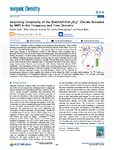Mostrar o rexistro simple do ítem
Surprising Complexity of the [Gd(AAZTA)(H2O)2]− Chelate Revealed by NMR in the Frequency and Time Domains
| dc.contributor.author | Lalli, Daniela | |
| dc.contributor.author | Carniato, Fabio | |
| dc.contributor.author | Tei, Lorenzo | |
| dc.contributor.author | Platas-Iglesias, Carlos | |
| dc.contributor.author | Botta, Mauro | |
| dc.date.accessioned | 2022-06-07T07:50:35Z | |
| dc.date.available | 2022-06-07T07:50:35Z | |
| dc.date.issued | 2021-12-10 | |
| dc.identifier.citation | Lalli, D.; Carniato, F.; Tei, L.; Platas-Iglesias, C.; Botta, M. Surprising Complexity of the [Gd(AAZTA)(H 2 O) 2 ] − Chelate Revealed by NMR in the Frequency and Time Domains. Inorg. Chem. 2022, 61 (1), 496–506. https://doi.org/10.1021/acs.inorgchem.1c03194. | es_ES |
| dc.identifier.issn | 1520-510X | |
| dc.identifier.issn | 0020-1669 | |
| dc.identifier.uri | http://hdl.handle.net/2183/30842 | |
| dc.description.abstract | [Abstract] Typically, Ln(III) complexes are isostructural along the series, which enables studying one particular metal chelate to derive the structural features of the others. This is not the case for [Ln(AAZTA)(H2O)x]− (x = 1, 2) systems, where structural variations along the series cause changes in the hydration number of the different metal complexes, and in particular the loss of one of the two metal-coordinated water molecules between Ho and Er. Herein, we present a 1H field-cycling relaxometry and 17O NMR study that enables accessing the different exchange dynamics processes involving the two water molecules bound to the metal center in the [Gd(AAZTA)(H2O)2]− complex. The resulting picture shows one Gd-bound water molecule with an exchange rate ∼6 times faster than that of the other, due to a longer metal–water distance, in accordance with density functional theory (DFT) calculations. The substitution of the more labile water molecule with a fluoride anion in a diamagnetic-isostructural analogue of the Gd-complex, [Y(AAZTA)(H2O)2]−, allows us to follow the chemical exchange process by high-resolution NMR and to describe its thermodynamic behavior. Taken together, the variety of tools offered by NMR (including high-resolution 1H, 19F NMR as a function of temperature, 1H longitudinal relaxation rates vs B0, and 17O transverse relaxation rates vs T) provides a complete description of the structure and exchange dynamics of these Ln-complexes along the series. | es_ES |
| dc.description.sponsorship | This research was supported by the Università del Piemonte Orientale (Ricerca locale FAR2019). F.C., L.T., and M.B. acknowledge the financial support from the Ministero dell’Università e della Ricerca (PRIN 2017A2KEPL project “Rationally designed nanogels embedding paramagnetic ions as MRI probes”). This work was carried out within the framework of the COST CA15209 Action “European Network on NMR Relaxometry” | es_ES |
| dc.description.sponsorship | Italia. Ministero dell'Università e della Ricerca; PRIN-2017A2KEPL | es_ES |
| dc.language.iso | eng | es_ES |
| dc.publisher | American Chemical Society | es_ES |
| dc.relation.uri | https://doi.org/10.1021/acs.inorgchem.1c03194 | es_ES |
| dc.rights | Atribución 3.0 España | es_ES |
| dc.rights.uri | http://creativecommons.org/licenses/by/3.0/es/ | * |
| dc.title | Surprising Complexity of the [Gd(AAZTA)(H2O)2]− Chelate Revealed by NMR in the Frequency and Time Domains | es_ES |
| dc.type | info:eu-repo/semantics/article | es_ES |
| dc.rights.access | info:eu-repo/semantics/openAccess | es_ES |
| UDC.journalTitle | Inorganic Chemistry | es_ES |
| UDC.volume | 61 | es_ES |
| UDC.issue | 1 | es_ES |
| UDC.startPage | 496 | es_ES |
| UDC.endPage | 506 | es_ES |
Ficheiros no ítem
Este ítem aparece na(s) seguinte(s) colección(s)
-
GI-REACT! - Artigos [113]






